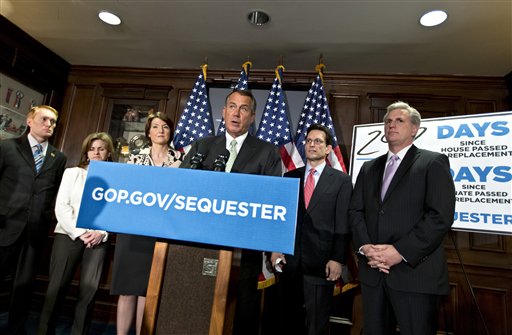Sequestration Comes to Appalachia
By Melanie Foley
Legislative Policy and Research Assistant, Summer 2013
In August 2011, Congress and President Obama made a pact. They agreed to $1.2 trillion worth of cuts over 10 years if another deficit reduction compromise could not be reached. Efforts to avoid the severe and widespread cuts failed, and as of the beginning of this month the sequester is in effect. President Obama, as required by law, has signed an order withdrawing $85 billion for the seven months left in fiscal year 2013. The Office of Management and Budget released a report calculating reductions of 13 percent for defense programs, and nine percent for non-defense programs over the remaining year.

The Democrats on the U.S. House of Representatives Appropriations Committee released an analysis of nationwide effects of the sequestration predicting a major reduction in U.S. Environmental Protection Agency air quality enforcement due to loss of manpower and cuts to monitoring systems — an estimated 1,000 fewer inspections. The members cautioned that, “shutdown of some air monitoring sites would make it more difficult if not impossible to determine if some areas of the country meet Clean Air Act standards.” This is bad news for Appalachia, which is overrun with aging coal plants, high incidents of asthma, lung cancer and other respiratory diseases.
Reduced enforcement for clean air and water will threaten environmental and public health in every state. But here are the figures from The White House on reductions in Central Appalachian states:
Cuts for Clean Air and Water by State:
Kentucky – $2,100,000
North Carolina – $3,606,000
Tennessee – $2,211,000
Virginia – $2,997,000
West Virginia – $2,013,000
Cuts to the EPA will make state enforcement even more important. Unfortunately, states are failing on both rulemaking and enforcement levels. In a recent congressional hearing on the role of states in environmental protection, North Carolina state Rep. Pricey Harrison listed examples of states’ failure to pass aggressive protections or even enforce existing laws. She told members of the House Subcommittee on Environment and the Economy that “members of Congress would serve their constituents best by allowing agencies like the EPA to do their job and providing them the resources they need to do it effectively.”
The OMB report includes a reduction of $10 million (eight percent) from the operating budget of The Office of Surface Mining Reclamation and Enforcement (OSMRE). Further cuts to the OSMRE budget mean a reduction of $13 million for the United Mine Workers of America health funds.
OSMRE is also set to lose 10 percent of its funds for the Abandoned Mine Land cleanup program. The agency says the loss will cause 50 AML projects to remain unreclaimed, and 22,500 citizens to remain exposed to dangerous and unhealthy conditions. OSMRE predicts that due to cuts over the next year, “1,800 acres of polluted or degraded mine lands will not be cleaned up, and over $4.3 million will not be set aside for cleanup of mine-related water pollution.”
As enforcement for environmental standards dwindles, so too does our capacity to diagnose and treat existing victims of dirty air and water. Some health programs such as Medicare face a two percent reduction, but others face the same eight to 10 percent cuts as other discretionary programs. The Centers for Disease Control and Prevention caution that the cuts will lead to impeded ability to address disease outbreak, fewer first responders, and less life-saving health research.
Many of the above cuts also have economic consequences. For example, OSMRE predicts that fewer cleanups will result in fewer contracts and jobs in mining communities. Reduced air and water quality enforcement also hurt jobs and gross domestic product. American Rivers recently examined the connection between water quality enforcement and the economy using studies from the U.S. Department of Commerce. The organization reported that every dollar invested in water infrastructure raises GDP by $6.35 in the long term, and one water infrastructure job creates 3.86 associated jobs in the national economy.
Finally, the White House and the House Appropriations Committee foresee increased processing time for agencies that issue mining permits. This could conceivably mean a slowdown in energy development on public lands. And we’re fortunate for that fact. We should not be spending money on issuing new permits when we don’t have the money to repair coal mining’s past and ongoing damage.



Leave a Reply